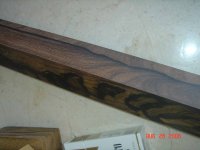maybe this one is not rotten
Arnot Wadsworth said:I see - if you use only lightly spalted wood and core it you get a "half rotton cue".
Don't kid yourself - rotton is rotton - even it it looks pretty to you. To me it is ugly and unsuitable for a cue regardless of who made it.
It is beyond me why any cuemaker would use spalted wood when there are so many wonderful woods readily available that look beautiful and are durable.
Spalted wood is NOT
Good cumaking
HI what do you thing of this wood? preety sure is not rotten ( but i,m not expert )
